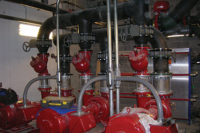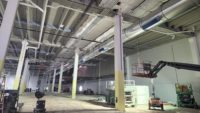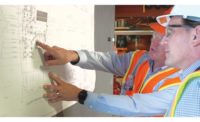The work for Phil Boyd, the chief engineer for Seattle-based Martin Selig Real Estate, never stops. Today, at least, it is more manageable.
That is because the company’s 43-story property at 1000 2nd Ave. in the heart of the Emerald City’s financial district — and only blocks away from the Puget Sound waterway — underwent a major overhaul of its domestic water pressure boosting system.
The six-month process, which included pre- and post-energy audits by Grundfos and Seattle’s publicly-owned energy utility company went so well that the property management firm incorporated the same technology at two of its other major properties.
“There is never any extra time. Now, we are not as far behind as we used to be,” Boyd chuckles.
The original system, which featured 27-year-old pumps from when the building was constructed in 1987, was designed to provide the same amount of water pressure to the entire 411,000-sq.-ft. facility throughout the day. The first, 20 horsepower smaller pump would fire up and then the remaining two 30 horsepower vertical turbine pumps would stage on.
“You had the first pump running and as soon as it got above the small threshold, it brought on the big pump,” Boyd says. “Whether you just needed a little bit or medium amount of flow, it did not matter. Then your pressure-reducing valves would lower the pressure in the building so it was not too much.”
One pump would run 24 hours a day regardless of flow needs, even on nights and weekends when the building was unoccupied. Beyond wasting energy, the original setup lowered the equipment’s life expectancy because of excessive heat and hydraulic forces on the pumps.
Maintenance costs and labor hours were piling up on the old system as well. Boyd explains, once a quarter, the original pumps had to be lubricated, and once a year a seal and/or bearing would have to be replaced.
“That was a couple-day project,” he says about the seal/bearing replacement. “It is something I do not have to worry about anymore.”
Getting started
Boyd and Martin Selig considered a $17,000 rehab of the existing pumps, but Grundfos came to the table and brought up an alternate plan to consider. The Olathe, Kan.-based manufacturer and Corey Rasmussen, a Grundfos sales manager, suggested Martin Selig spend its money on a new and more efficient booster system.
To prove a new system was the correct course of action, an independent energy audit was commissioned to determine 1000 2nd Ave.’s pressure needs.
The audit was conducted over a two-week period in late August 2014 with equipment installed to monitor the flow, pressure and power. After it was concluded it showed the original system utilized:
- 132,132 kWh average annual consumption; and
- $19,820 annual operating cost based on $0.15/kWh.
Utility comes through
Boyd and Martin Selig sought more savings by working with the city’s local energy utility, Seattle City Light and its Energy Smart Services program. The utility provides incentives for medium and large businesses that reduce their electricity use.
The team worked with Lisa Frasene, an energy management analyst with Seattle City Light, on a custom incentive program. Frasene says the 1000 2nd Ave. program is a “custom incentive project” where the utility’s Conservation Resources Division calculates a kWh savings estimate by working in concert with City Light’s technical metering team. The metering team installs its own power loggers to quantify the kWh usage before and after the new energy-efficient equipment is installed.
“Our metering team uses standard procedures and best practices when installing power meters for each customer,” Frasene says. “Grundfos provided a unique comprehensive audit report specific to 1000 2nd Avenue’s domestic water pressure boosting system to City Light for review based on its own power logging. Not every company City Light works with provides a detailed audit.
“I compared City Light’s data to Grundfos’ data and it was comparable; their estimated contracted savings was only 2,329 kWh less than their software estimated or about 2% off. This confirmed the consistency in the data, which in turn validated the accuracy of Grundfos’ audit.”
From there, Frasene explains, incentives are based on the total kWh savings over the project’s first year. In addition, combined rebates from all utilities may not exceed 70% of the project costs and the incentive amount is capped to a minimum payback period of six months.
For 1000 2nd Ave., Seattle City Light offers a $0.27/kWh reduction in the first year of operation. When Frasene’s portion of the 1000 2nd Ave. audit was completed, she walked away satisfied.
“I was very impressed by the accuracy of Grundfos’ software and the reported kWh savings,” she states.
The new toys
After hearing from Seattle City Light and learning about the new domestic water pressure boosting system Martin Selig could install, Boyd got the go-ahead to revamp 1000 2nd Ave.’s operations.
First, Grundfos’ Hydro MPC BoosterpaQ was installed. The BoosterpaQ is an integrated pressure boosting system that delivers the exact pressure necessary for ideal performance without human intervention. It also uses an advanced controller to adjust pump speed and turn on additional pumps when necessary for specific demand needs.
Next, Grundfos CR vertical multi-stage centrifugal pumps were put in place and coupled to a 7.5 horsepower Grundfos MLE integrated variable-speed drive and motor.
“The variable-speed pumps give you a variable drive that gives the building what it needs on demand,” Boyd states. “Typically, it is 60 Hz, but it can be 30 Hz or even lower. We are progressively staging on the next pump as needed. Once that pump gets to its maximum, then we bring on the next pump at its minimum. Then we can progressively add the flow and the pressure.”
Boyd continues: “The variable-speed pumps give a variable drive. It provides the building what it needs on demand.”
The Multi-Pump Controller manages the VFD-controlled pumps in parallel fashion and the performance curves are loaded into the controller on the Hydro MPC BoosterpaQ. Next, the BoosterpaQ chooses the highest efficient combination of pumps and speed to exactly match the flow and pressure demand.
In the end, the new systems average an output of one (variable-speed pump) at 30% output and have an average annual consumption of 11,065 kWh with an annual operating cost of $1,660. That equals 92% annual savings compared to the original domestic water boosting system.
Tallying it up
The 1000 2nd Ave. building’s projected first-year costs from the audit were:
- System cost = $61,521;
- Utility incentive = $29,328; and
- Annual cost/energy savings = $7,604 (an 86% reduction in energy and 108,624 kWh/year).
The simple payback is estimated to be slightly more than five years, which is right at or a cut-above the similar projects.
“From the handful of full domestic water pressure boosting projects I have been involved with,” Frasene states, “this projected payback is expected to be in-line or better than comparable buildings.”
Boyd believes this new system might not have been workable without the incentive program Seattle City Light, Grundfos and Martin Selig worked to achieve. “The incentive program was a big part of this project,” he says.
With the major success at 1000 2nd Ave., Boyd received the go-ahead to make similar upgrades at two other Martin Selig Real Estate properties. The first was at 2104 4th Ave., better known as the Fourth and Blanchard building. That property is 25 stories, covers 390,000 sq. ft. and had a tri-plex boosting system with one 15 horsepower and two 25 horsepower fixed-speed pumps.
A Hydro MPC pressure-boosting system was installed and utilizes three CRE 10-6 pumps, each controlled by a 5 horsepower variable-speed pump. The Fourth and Blanchard building — which Boyd says is in the middle of installing low-flow Zurn toilets to help save additional water and energy — saw similar results to 1000 2nd Ave.
- System cost = $63,183;
- Utility incentives = $17,009; and
- Annual energy savings = $5,055 (84% reduction and savings of 63,000 kWh/year).
The savings achieved at Fourth and Blanchard are similar to 1000 2nd Ave, except that the utility incentive is lower because the building is not as tall and requires a smaller pump system.
The final Martin Selig Real Estate project was undertaken at 2401 2nd St. – also known as the Fourth and Battery building. This project — which, Boyd notes, has completed its Zurn HET retrofit, is a 12-story high-rise that had a duplex pressure boosting system with full-speed 5 horsepower end-suction pumps.
Martin Selig replaced the original system with a Hydro MPC BoosterpaQ equipped with two variable-speed 1.5 horsepower CRE Grundfos pumps. The new system reduced energy savings by 94%, but the smaller size of the building significantly lowered the utility incentive.
The results at Fourth and Battery came out to be:
- System cost = $47,383;
- Utility incentive = $6,700; and
- Annual energy savings = $2,000 per year.
Frasene was impressed with the scope and savings that Martin Selig, Grundfos and her City Light team derived. She hopes they all can work together again on any of Martin Selig’s 26 properties in Seattle.
“Martin Selig Real Estate not only makes energy conservation a top priority, but it actively takes advantage of City Light’s numerous programs and incentives,” she says. “Phil also was great to work with because he is motivated and proactive. I look forward to working with everyone again.”
Boyd is quick to point out he has no say in how Martin Selig will use the money saved by the three retrofits, but knows his employers are very happy with the end results.
“They are happy to see the new income,” he says.
This article was originally titled “A Perfect Mix” in the August 2015 print edition of PM Engineer.







